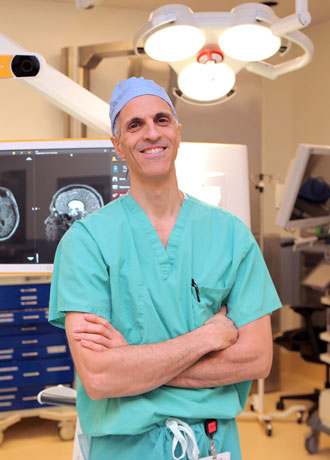Dr. Mark Souweidane and colleagues from the Weill Cornell Medicine Children’s Brain Tumor Project have published three new academic articles on findings from their pediatric neuro-oncology research. Together with previously published papers that resulted from Dr. Souweidane’s Phase I clinical trial testing convection-enhanced delivery (CED) for brainstem gliomas, these new papers significantly expand scientific knowledge in the field.
"B7–H3 As a Prognostic Biomarker and Therapeutic Target in Pediatric Central Nervous System Tumors”
Published in the February 2020 issue of Translational Oncology
Authors: Uday B. Maachani, Umberto Tosi, David J. Pisapia, Sushmita Mukherjee, Christopher Marnell, Julia Voronina, Daniel Martinez, Mariarita Santi, Nadia Dahmane, Zhiping Zhou, Cynthia Hawkins, Mark M. Souweidane
B7-H3, a member of the B7 family of immunoregulatory proteins, is an immune checkpoint molecule previously found to be associated with malignant tumors. Dr. Souweidane’s group had earlier reported on the overexpression of B7–H3 and the potential for antibody-based targeted therapy against it, in diffuse intrinsic pontine glioma (DIPG), a pediatric brain tumor. The role of the protein in other pediatric brain and spine tumors was largely unknown. (More about DIPG.)
To better understand that role, Dr. Souweidane and an all-star team that included Dr. Nadia Dahmane and Dr. David Pisapia of Weill Cornell and Dr. Cynthia Hawkins of Toronto Sick Kids examined more than 300 tumor specimens obtained via biopsy or autopsy. The specimens represented a wide range of tumor types and included AT/RT, ependymoma, medulloblastoma, craniopharyngioma, and multiple types of gliomas. Researchers studied the samples to compare B7-H3 expression against overall survival in various pediatric CNS tumor types.
The study showed almost universally high expression of B7-H3 in tumor tissue when compared with what was measured in healthy control specimens, and established B7–H3 as a promising target for new drugs to combat pediatric brain tumors.
More about the paper on Science Direct
“Deformational Changes After Convection-Enhanced Delivery in the Pediatric Brainstem”
Published in the January 2020 Issue of Neurosurgical Focus (Pediatric Brain Tumor: Evolving Treatment Strategies)
Authors: Bander ED, Tizi K, Wembacher-Schroeder E, Thomson R, Donzelli M, Vasconcellos E, Souweidane MM.
One of the observations made during Dr. Souweidane’s clinical trial of CED was that the brainstem and ventricles became enlarged during and following the infusion. It was unknown whether that increase in volume was cause for concern, had a lasting effect, or would affect clinical management. As part of the learning that has come out of the CED trial, Dr. Souweidane and his team measured treatment-related volumetric alterations in the brainstem and ventricles and found them to be self-limiting.
Between 2012 and 2019, pre-operative MRI scans of 23 young patients were compared with scans done the day after the infusion and again 30 days later. They were analyzed using iPlan Flow software, which found a significant increase in volume immediately after the infusion, and a return to baseline shortly thereafter. None of the patients were diagnosed with obstructive hydrocephalus or required shunt placement.
More about the paper on PubMed
“The Intersect of Neurosurgery with Diffuse Intrinsic Pontine Glioma”
Published in the December 2019 issue of the Journal of Neurosurgery Pediatrics
Authors: Kuzan-Fischer CM, Souweidane MM
It seemed paradoxical at first when the Journal of Neurosurgery invited Dr. Souweidane to contribute an article about DIPG for its 75th anniversary issue, since DIPG has traditionally had no neurosurgical options. That invitation, however, marks a turning point of sorts in the approach to this uniformly fatal brain tumor – a turning point that is largely thanks to Dr. Souweidane’s efforts over the past two decades.
This comprehensive article covers the sweep of neurosurgical history on DIPG, from positions of futility and abandonment to cautious optimism and progress. It summarizes new opportunities for neurosurgeons as they take on a role in tissue sampling, research, and drug delivery. Biopsies once considered beyond possibility now produce samples for scientific study; new sources of funding, often from galvanized parents and families; and new approaches to drug delivery have created new potential for treating this deadly tumor.
This important new paper serves to educate pediatric neurosurgeons about this new potential and raise their awareness of new treatments on the horizon.
More about the paper on PubMed
More about the Children's Brain Tumor Project at Weill Cornell Medicine


